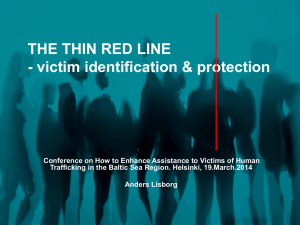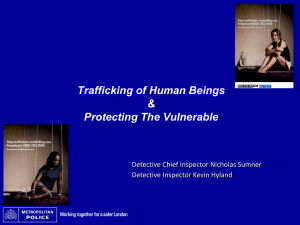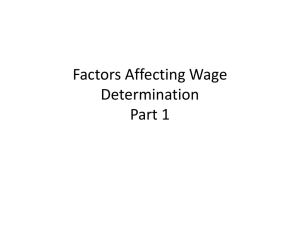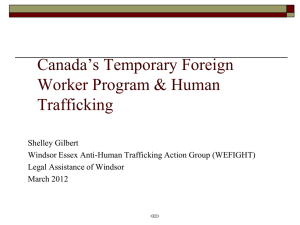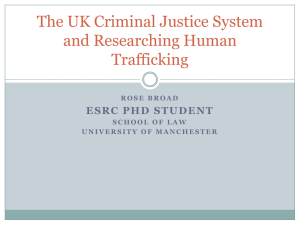Improved detection
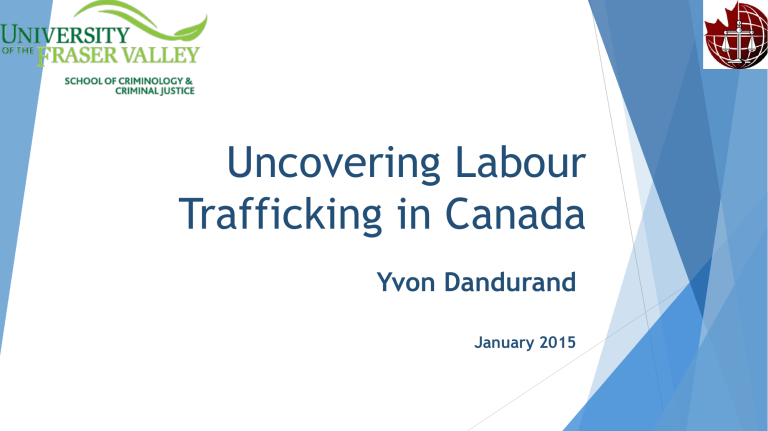
Uncovering Labour
Trafficking in Canada
Yvon Dandurand
January 2015
Issue
Labour trafficking has not received sufficient attention
Very few cases of labour trafficking have been identified in Canada, although there have been a few more cases recently
Victims of labour trafficking rarely report their experience to the authorities
It is important to understand why labour trafficking victims do not seek the protection of the justice system
Our knowledge on the prevalence of this crime in Canada is still very limited
We need to better understand the challenges associated with the detection, investigation and prosecution of labour trafficking incidents.
The Project
GOAL: To understand how to improve the way instances of labour trafficking are detected, investigated and prosecuted in Canada.
METHOD: Combined “action research” with a “stakeholder engagement” exercise.
RESULTS: A review of current challenges and proposed solutions based on the experiences of key stakeholders in four major Canadian cities, on other informal consultations and on a review of the literature.
Objectives of Four Roundtable Meetings
Montreal – Toronto -Calgary - Vancouver
A fact finding objective
A didactic objective
A professional networking objective
Questions addressed during meetings
Existing cases : Have there been cases (or suspected cases) of labour trafficking in this region? What did these cases involve? How were they detected? Were they investigated – by whom? Did the investigation confirm that labour trafficking was involved?
Challenges encountered: What challenges have participants already identified with respect to the detection, investigation and prosecution of labour trafficking cases?
Improving reporting by victims : Can something be done to assist victims and persuade them somehow to come forward and seek the protection of the justice system?
Role of labour inspectors and other regulatory agencies : What role, if any, did participants see regulatory agencies play in the detection of cases of labour trafficking? Are these regulatory agencies currently contributing to the detection of labour trafficking incidents? If yes, how do they so? If not, why not? Is it worth further exploring this potential role? What would be required to further develop this role?
Improved Interagency Cooperation : How can we improve inter-agency cooperation in the detection, investigation and prosecution of labour trafficking cases? What are some of the best practices in that regard?
The Findings
Improved understanding of labour trafficking
Improved prevention
Improved detection and victim identification
Improved investigations
Improved prosecutions
Improved understanding
Understanding of the law
There is still some confusion about the definitions of labour trafficking in IRPA and in the Criminal Code
Mistaken emphasis of some agencies on trying to define what level of exploitation amounts to labour trafficking.
Training on how to interpret the law still required
The new FPT Working Group Handbook for Criminal
Justice Practitioners on Human Trafficking will be helpful in that regard
Understanding labour trafficking as a process
labour trafficking, forced labour and other forms of labour exploitation are all part of a continuum of exploitation
and coercion, with clear cut labour cases at one end of that continuum and much more subtle forms of exploitation and coercion at the other end.
labour trafficking primarily takes place in the context of the exploitation of migrant labour.
It is crucial to better understand these patterns and their implications for regulators, investigators and prosecutors.
Understanding the vulnerability of migrant workers and undocumented workers
Labour trafficking primarily takes place in the context of exploitation of migrant labour.
Victims of forced labour or labour trafficking often do not see themselves as victims, but rather as workers in a difficult situation.
Two main groups of immigrants at risk of being trafficked for the purpose of labour exploitation
:
undocumented migrant workers;
Migrant workers who come to Canada legally under a TFW program.
Both groups are very vulnerable to labour exploitation
(isolation, cultural factors, fear of deportation, large debt contracted to come to Canada)
Domestic workers and farm workers are particularly vulnerable due to the nature of their work, their working conditions, and their isolation.
Structural factors increase the vulnerability of migrant workers
The role of intermediaries (e.g. recruitment agencies, brokers, etc.) and the lack of effective monitoring of their activities.
Immigration policies (no path to regularization for undocumented workers)
The structure of existing FTW Program
E.g. Work permits attached to one employer instead of sector-wide permits
Understanding patterns of victim exploitation
Forced labour is better understood as “a process and not as a static relationship between workers and employers”.
Recent amendments to the Criminal Code have helped define what is meant by exploitation (section 279.04).
It is also important to recognize that, although the law makes a distinction between labour trafficking and sexual trafficking, the reality of many victims is that they are subjected to both forms of exploitation.
Some people complain that they are unfamiliar with what distinguishes violations of labour standards from labour trafficking. Exploitation however can be defined on a continuum and that it tends to evolve over time. It is the coercion and the deception which accounts for the difference between labour exploitation and labour trafficking. Otherwise, it would simply be a matter of what the workers are prepared to accept.
Understanding patterns of control and coercion
The methods of coercion and control used by labour traffickers tend to be poorly understood by law enforcement or criminal justice officials.
It is important to understand the relationship between offenders and victims in order to improve current prevention and enforcement strategies.
It is important to understand histories and relationships between offenders and victims and the situations that enable these relationships to be manipulated for criminal purposes.
Non-physical methods of control over the victims are used depending on the victim’s susceptibility and context.
Psychological coercion is subtle, effective, and difficult to prove
IMPROVED PREVENTION
IMPROVED PREVENTION
Labour trafficking is best addressed through preventative measures that tackle victimization before it occurs .
Methods suggested:
Improving the monitoring of the TFW Program;
Improving employment standards, enhancing worker protection laws, and enhancing labour standards enforcement;
Ensuring that intermediaries (agents, brokers) are effectively regulated and monitored;
Providing information to employers;
Providing information to workers.
Improved detection
Improved detection:
Mitigating the risks associated with reporting
By reporting their victimization to the police, victims of labour trafficking may be exposing themselves to a host of other risks, including retaliation by the offenders or their accomplices, deportation, penalties and even persecution in their own country upon their return.
These other risks can be mitigated:
Protective measures
Facilitated access to TRP
Regularization of immigration status
Predictable and fair pathways to permanent resident status
Improved detection:
Increased victim support and access to redress
The success of a labour trafficking investigation and prosecution depends on the collaboration of victims.
Victims with no viable alternatives to their situation are unlikely to report the crime.
If the crime is being investigated, the investigation and prosecution process is often a long one and victims, typically irregular migrants or temporary foreign workers will have most likely lost the means to support themselves and will be totally dependent on support and assistance.
Victims of labour trafficking have very few effective remedies available to them – for example, for regaining lost wages or obtaining compensation for injury. There are few incentives for them to report their victimization.
Improved detection:
Improvements to the TFW Program
It was also suggested that employers’ compliance with program conditions and standards should be more diligently monitored and enforced.
Penalties and other consequences should be imposed on noncompliant employers and agencies.
Improved investigations
Investigations
More proactive investigations
Greater priority to be given to labour trafficking investigations
Greater interagency cooperation required
Collaboration with regulatory agencies
Little collaboration so far
General willingness to explore the possibility
There will be some limits to the mode and scope of information exchanges between regulatory and law enforcement agencies
Training will be required
Formal protocols and information sharing agreements will be necessary
Collaboration with managers of TFW Program will be required
Improved prosecutions
•
•
•
•
Little experience to date
Specialization of prosecutors is important
Corroborating evidence is often difficult to produce
Prosecution must work closely with victim assistance organizations
Conclusions
The identification of victims of labour trafficking will likely continue to be problematic
The consequences for victims of reporting their victimization are potentially huge and negative effects of the consequences must be mitigated
It is important to understand the many ways in which migrant workers become vulnerable to labour trafficking – it is important to ensure that immigration policies, immigration law enforcement and TFW
Program conditions do not further compound that vulnerability
Some specific measures can be taken to improve victim reporting rates
Proactive investigation is absolutely essential
Proactive investigations can be facilitated by interagency collaboration and by linking some regulatory activities with law enforcement investigations
Yvon.Dandurand@ufv.ca
International Centre for Criminal Law Reform and Criminal Justice Policy

